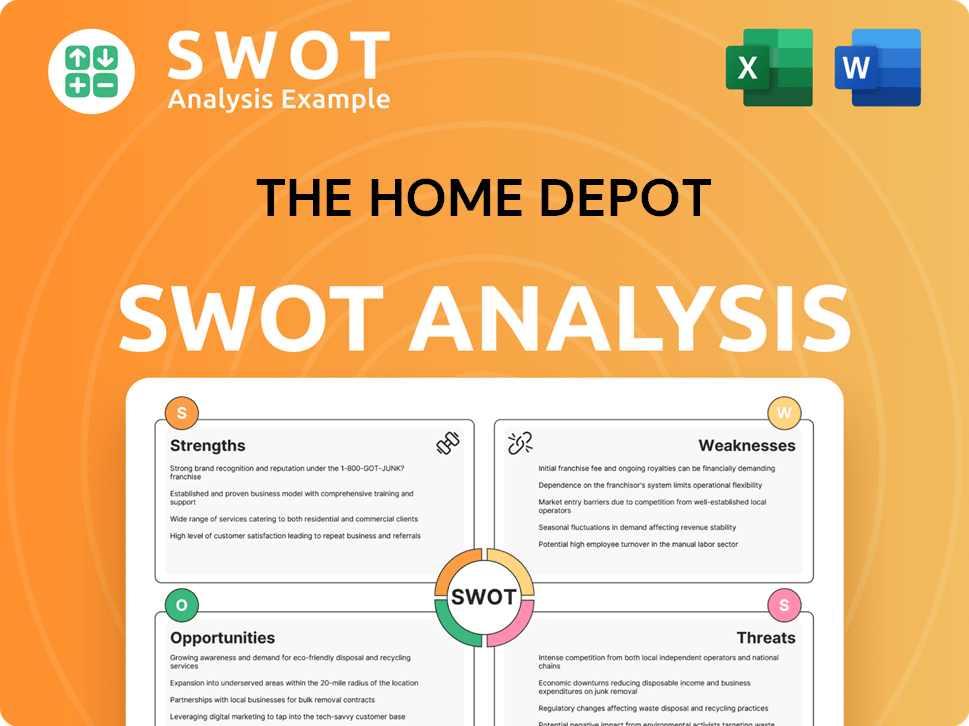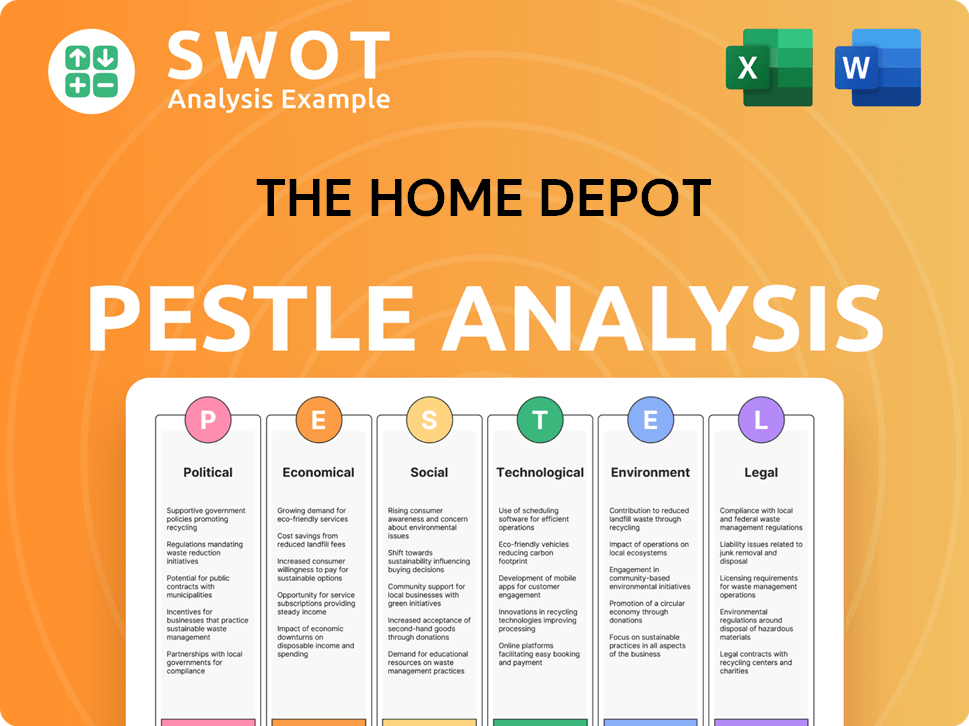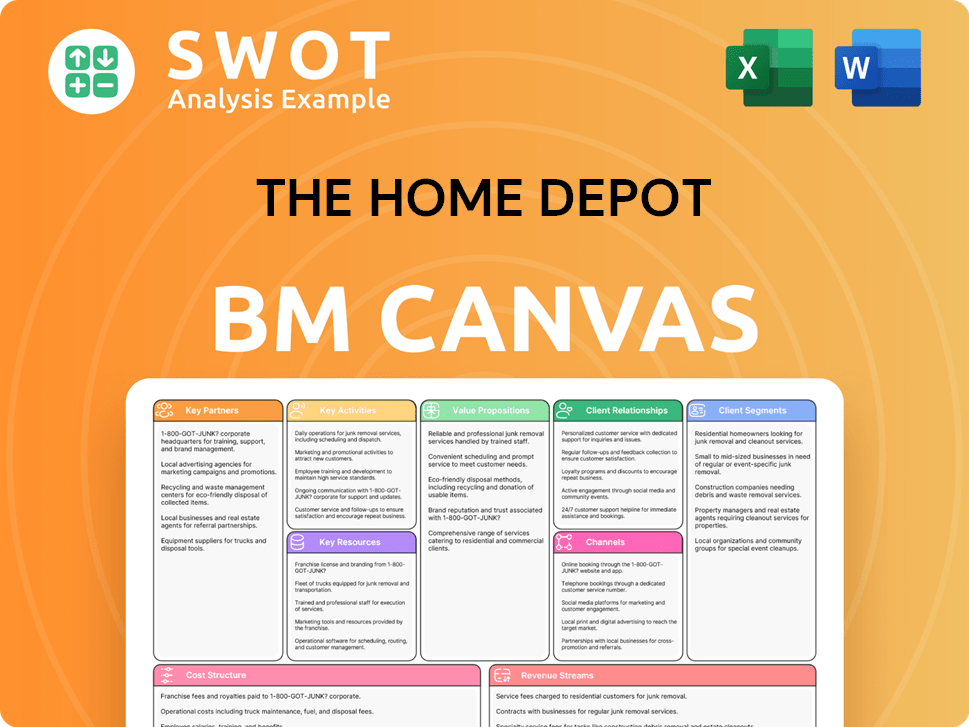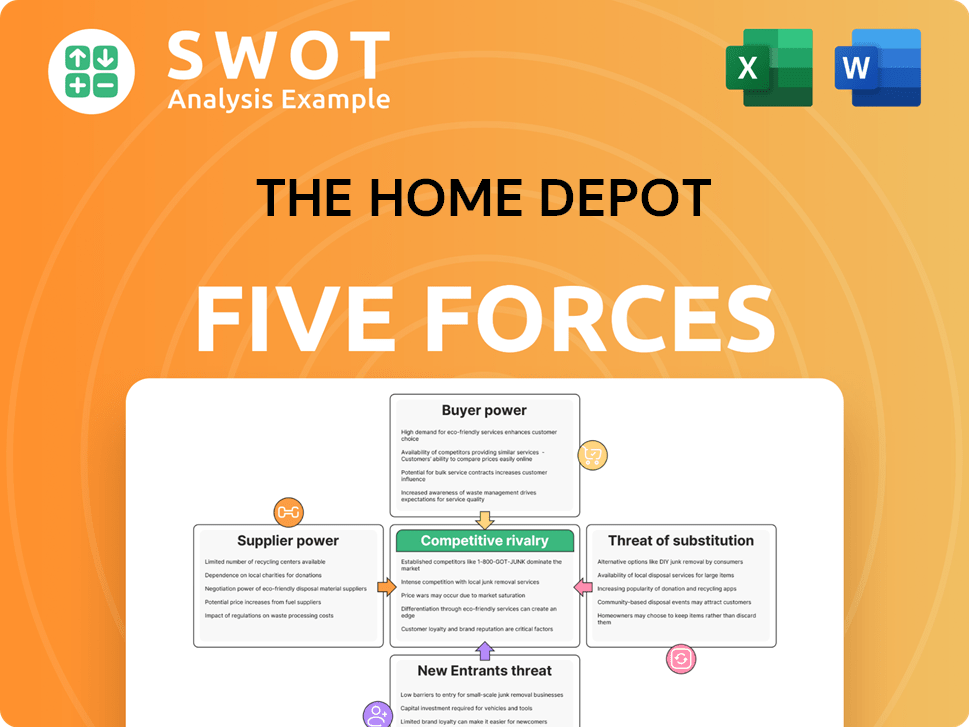The Home Depot Bundle
How Does Home Depot Dominate the Home Improvement Market?
Delve into the core strategies that have cemented The Home Depot's position as an industry leader. This exploration unveils the dynamic The Home Depot SWOT Analysis, examining how this retail giant leverages its sales and marketing prowess to thrive. From its innovative approach to customer experience to its expansive digital presence, discover the secrets behind Home Depot's enduring success.

This deep dive into Home Depot's sales and marketing strategy reveals how the company has consistently adapted to changing consumer behaviors and competitive pressures. Understanding the Home Depot business model, its targeted approach to the DIY and Pro customer segments, and its investment in digital capabilities provides a comprehensive view of its market dominance. Analyzing Home Depot's marketing campaign examples and its focus on customer experience offers valuable insights into its sustained growth and market share analysis, making it a compelling case study for any business strategist.
How Does The Home Depot Reach Its Customers?
The Home Depot's sales strategy is built on a robust omnichannel approach, blending physical retail with digital platforms to serve a diverse customer base. This strategy is crucial for maintaining its market position and driving growth within the competitive home improvement sector. The company's focus on enhancing customer experience across all channels, from in-store interactions to online purchases, is a key element of its success.
As of February 4, 2024, The Home Depot operated a vast network of 2,335 retail stores across North America. These stores offer a wide array of products and services, including building materials, home décor, and installation services. Simultaneously, the company has invested significantly in its e-commerce capabilities, allowing customers to shop online and choose options like in-store pickup.
The integration of physical and digital channels is a core aspect of The Home Depot's business model, enhancing customer convenience and operational efficiency. This strategy, combined with targeted sales initiatives for professional customers, supports the company's overall growth objectives. Understanding the Target Market of The Home Depot helps to appreciate how these channels cater to different customer segments.
The cornerstone of The Home Depot's sales strategy is its extensive network of physical stores. These large-format stores offer a wide range of products, from building materials to home décor, and provide in-store services. Continuous improvements in store layouts and customer experience are key to attracting and retaining customers.
The Home Depot's e-commerce platform, homedepot.com, has seen significant growth, accounting for approximately 15% of total sales in fiscal year 2023. This channel offers convenience, allowing customers to browse products, make purchases, and choose delivery or in-store pickup options. The digital marketing strategy is crucial for driving online sales.
The company engages in direct sales to professional customers through its Pro Xtra program and dedicated sales teams. This approach offers tailored services, bulk pricing, and specialized product access. Strategic partnerships with brands also enhance product offerings and attract specific customer segments.
The Home Depot's omnichannel strategy integrates online and offline experiences seamlessly. Services like 'Buy Online, Pick Up In Store' and 'Buy Online, Deliver From Store' blur the lines between digital and physical retail. This integration enhances customer satisfaction and operational efficiency, contributing to the overall Home Depot sales strategy.
The Home Depot's sales and marketing tactics are designed to maximize customer reach and sales. The company focuses on providing a seamless customer experience across all channels, supported by data-driven insights.
- Optimize store layouts and product assortments to enhance the in-store customer experience.
- Invest in digital marketing to drive online sales and improve the online customer experience.
- Develop specialized programs and services for professional customers, such as the Pro Xtra program.
- Form strategic partnerships to expand product offerings and attract specific customer segments.
The Home Depot SWOT Analysis
- Complete SWOT Breakdown
- Fully Customizable
- Editable in Excel & Word
- Professional Formatting
- Investor-Ready Format

What Marketing Tactics Does The Home Depot Use?
The company's marketing strategy is a comprehensive approach that blends digital and traditional methods to build brand awareness and drive sales. This strategy focuses on creating a strong customer experience and leveraging data to personalize marketing efforts. The company's success is rooted in its ability to adapt to changing consumer behaviors and market trends.
The company's marketing tactics are designed to engage customers across multiple touchpoints, from online platforms to in-store experiences. The company emphasizes content marketing, search engine optimization (SEO), and targeted advertising to reach its audience. The company also uses traditional media, such as television and radio, to maintain a broad reach.
The company's approach to marketing is increasingly data-driven, using analytics to understand customer behavior and personalize marketing messages. This data-driven approach allows the company to precisely segment its customer base and tailor promotions accordingly. The company's marketing mix has significantly evolved with a greater emphasis on digital channels and omnichannel integration.
The company heavily invests in digital marketing to reach its target market. This includes content marketing, SEO, and paid advertising. The company's digital marketing strategy focuses on providing valuable resources and engaging content to attract and retain customers.
The company's website and blog offer extensive how-to guides, project ideas, and product information. This positions the company as a trusted resource for home improvement. Content marketing helps build brand awareness and drive organic traffic.
SEO is crucial for ensuring high visibility in search engine results. The company uses SEO to capture organic traffic from customers actively seeking home improvement solutions. Effective SEO drives traffic to the company's website and product listings.
The company strategically uses paid advertising, including search engine marketing (SEM) and display ads. These ads target specific customer segments with relevant product promotions and brand messages. Paid advertising helps reach a wider audience and drive sales.
Email marketing is a key tactic for customer retention and engagement. The company sends personalized newsletters, promotional offers, and project inspiration to subscribers. Email marketing helps build customer loyalty and drive repeat purchases.
The company utilizes social media platforms like Facebook, Instagram, YouTube, and Pinterest. These platforms showcase products, share DIY tips, and foster community engagement. Social media helps build brand awareness and connect with customers.
The company's marketing strategy also includes traditional media and a data-driven approach. Television and radio advertisements build brand awareness, especially during peak seasons. Data analytics helps the company understand customer behavior and personalize marketing messages. This approach allows for precise customer segmentation and targeted promotions.
- Television and radio advertisements are used for broad reach and brand building.
- Print advertising in relevant magazines and event sponsorships are also part of the marketing mix.
- The company leverages analytics to understand customer behavior and segment its audience.
- Advanced analytics tools track online browsing patterns, purchase history, and in-store interactions.
- The company uses data to differentiate between DIY enthusiasts and professional contractors.
The Home Depot PESTLE Analysis
- Covers All 6 PESTLE Categories
- No Research Needed – Save Hours of Work
- Built by Experts, Trusted by Consultants
- Instant Download, Ready to Use
- 100% Editable, Fully Customizable

How Is The Home Depot Positioned in the Market?
The company's brand positioning centers around empowering customers to complete home improvement projects. This is achieved by providing the products, knowledge, and confidence needed for success, differentiating it from competitors. The core message targets both DIY enthusiasts and professional contractors, positioning it as the go-to destination for all home improvement needs.
The visual identity, featuring the signature orange logo and warehouse-style setting, reinforces the brand's commitment to value and extensive selection. The tone of voice is helpful and authoritative, reflecting the expertise of its associates and the comprehensive nature of its offerings. The promise of a seamless customer experience, both online and in-store, is a key element of its brand strategy.
The company's unique selling proposition combines value, a vast product assortment, and unparalleled customer service. While not a luxury brand, it emphasizes quality and durability, appealing to customers seeking reliable solutions. Its appeal to professional contractors is built on efficiency, bulk purchasing options, and specialized services.
The company strategically targets a broad audience, including DIY homeowners and professional contractors. This dual focus allows for a wider market reach and caters to diverse needs. Understanding the specific needs of both customer segments is crucial for effective Home Depot sales strategy.
The company's value proposition combines competitive pricing, a wide product selection, and expert customer service. This approach ensures that customers receive value for their money. This strategy is a core element of its Home Depot marketing strategy.
Brand consistency is maintained across all channels, from in-store signage to the website and social media. This uniformity reinforces the brand's core values. This consistency is a key aspect of its Home Depot business model.
The company prioritizes a positive customer experience through convenience, product availability, and expert guidance. This approach includes both online and in-store interactions. Enhancing the customer experience is vital for Home Depot competitive analysis.
The company's brand positioning is built on several key elements that contribute to its success in the home improvement retail sector. These elements are critical for maintaining a strong market presence.
- Value and Quality: The company emphasizes both value and quality, appealing to customers seeking reliable solutions for their home improvement needs.
- Extensive Product Assortment: Offering a wide variety of products ensures that customers can find everything they need in one place, enhancing convenience.
- Customer Service: Providing expert guidance and support helps customers make informed decisions and complete their projects successfully.
- Omnichannel Strategy: Leveraging both physical stores and online platforms creates a seamless shopping experience, catering to evolving customer expectations.
The Home Depot Business Model Canvas
- Complete 9-Block Business Model Canvas
- Effortlessly Communicate Your Business Strategy
- Investor-Ready BMC Format
- 100% Editable and Customizable
- Clear and Structured Layout

What Are The Home Depot’s Most Notable Campaigns?
The company's sales and marketing strategies have been instrumental in shaping its brand identity and driving growth. Early campaigns, such as the 'You Can Do It. We Can Help.' initiative, focused on demystifying home improvement, positioning the company as a supportive partner. These early strategies helped establish a strong customer base and market presence. The success of these campaigns highlights the importance of understanding and addressing consumer needs in the home improvement sector.
More recently, the company has emphasized its Pro services and digital capabilities, targeting professional contractors with campaigns highlighting speed, convenience, and bulk savings. Seasonal campaigns, such as the 'Spring Black Friday' event, are also major sales drivers, featuring promotions across various product categories. These campaigns utilize a mix of digital advertising, targeted email marketing, and in-store promotions to drive traffic and boost sales. The company's approach combines traditional advertising with modern digital strategies.
The company's ability to adapt its sales and marketing tactics, such as its digital marketing strategy, has been crucial for maintaining its market share. The company's customer experience is a key factor in its success, with a focus on providing excellent service and product quality. The company's brand positioning has consistently reinforced its commitment to customer service and product reliability. For a deeper dive into the company's growth strategy, consider reading the article: Growth Strategy of The Home Depot.
Launched in the 1980s, this campaign aimed to make home improvement accessible to the average consumer. It focused on empowering individuals to tackle projects with readily available guidance. This approach successfully cultivated a perception of approachability and expertise, leading to increased sales.
These campaigns target professional contractors, emphasizing speed, convenience, and bulk savings. They use digital advertising, email marketing, and in-store promotions. The goal is to grow the Pro segment, which accounts for a significant portion of sales.
Events like 'Spring Black Friday' drive significant sales, featuring promotions on garden products and seasonal décor. These campaigns use cross-channel promotion, including TV, digital, and social media. Success is measured by sales lifts and increased foot traffic.
The company utilizes digital marketing to enhance its online sales strategy. This includes targeted advertising, social media presence, and email marketing. These efforts aim to improve the customer experience and drive online sales growth.
The sales strategy focuses on a mix of in-store and online experiences to maximize customer reach. The company's promotional strategies include seasonal sales events and targeted offers for professionals. The company's pricing strategy aims to be competitive while maintaining profitability.
The marketing strategy leverages digital platforms, social media, and traditional advertising. The company's advertising strategy includes a focus on brand building and product promotion. The company's social media presence is used to engage customers and promote products.
The business model is built on a large-format store concept with a wide product range. The company's supply chain management is crucial for efficiency and cost control. The company's growth strategy includes expanding its store network and online presence.
The company's competitive analysis involves monitoring rivals and adapting strategies. The company competes with other home improvement retailers and online marketplaces. The company's market share analysis helps in understanding its position in the market.
The target market includes DIY consumers and professional contractors. The company's customer relationship management focuses on building loyalty. The company's in-store experience is designed to enhance customer satisfaction.
The customer experience is a key focus, with an emphasis on product quality and service. The company uses data to understand and improve the customer journey. The company's brand positioning reinforces its commitment to customer service.
The Home Depot Porter's Five Forces Analysis
- Covers All 5 Competitive Forces in Detail
- Structured for Consultants, Students, and Founders
- 100% Editable in Microsoft Word & Excel
- Instant Digital Download – Use Immediately
- Compatible with Mac & PC – Fully Unlocked

Related Blogs
- What are Mission Vision & Core Values of The Home Depot Company?
- What is Competitive Landscape of The Home Depot Company?
- What is Growth Strategy and Future Prospects of The Home Depot Company?
- How Does The Home Depot Company Work?
- What is Brief History of The Home Depot Company?
- Who Owns The Home Depot Company?
- What is Customer Demographics and Target Market of The Home Depot Company?
Disclaimer
All information, articles, and product details provided on this website are for general informational and educational purposes only. We do not claim any ownership over, nor do we intend to infringe upon, any trademarks, copyrights, logos, brand names, or other intellectual property mentioned or depicted on this site. Such intellectual property remains the property of its respective owners, and any references here are made solely for identification or informational purposes, without implying any affiliation, endorsement, or partnership.
We make no representations or warranties, express or implied, regarding the accuracy, completeness, or suitability of any content or products presented. Nothing on this website should be construed as legal, tax, investment, financial, medical, or other professional advice. In addition, no part of this site—including articles or product references—constitutes a solicitation, recommendation, endorsement, advertisement, or offer to buy or sell any securities, franchises, or other financial instruments, particularly in jurisdictions where such activity would be unlawful.
All content is of a general nature and may not address the specific circumstances of any individual or entity. It is not a substitute for professional advice or services. Any actions you take based on the information provided here are strictly at your own risk. You accept full responsibility for any decisions or outcomes arising from your use of this website and agree to release us from any liability in connection with your use of, or reliance upon, the content or products found herein.